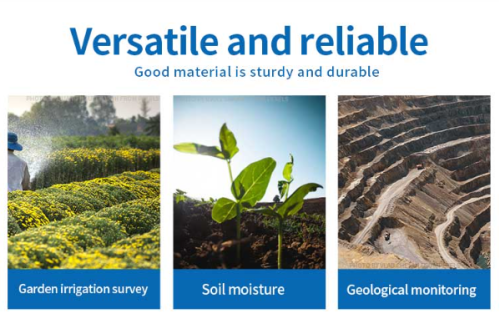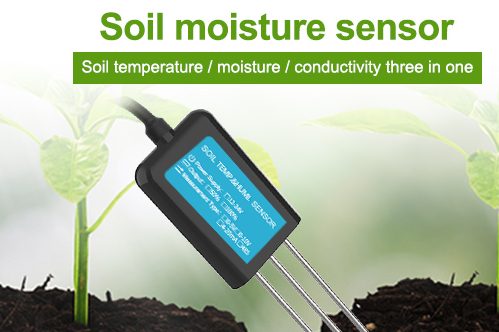Soil humidity sensor are essential tools for measuring soil moisture content, enabling farmers, foresters, and environmentalists to optimize water usage, prevent soil erosion. Soil humidity sensors are a type of soil moisture sensor that measures the amount of water in the soil. In this paper, we will explore the significance of soil humidity sensors in agriculture, forestry, and environmental management, their applications, and the impact they have on the sustainable management of our natural resources.
Understanding Soil Humidity Sensor

Soil humidity sensor are devices that measure the amount of water in the soil. They are based on the principle that the dielectric constant of soil changes with moisture content. Soil moisture sensors use this to measure the dielectric constant of the soil and convert it into a numerical value of the soil water content. There are several types of soil humidity sensors, including capacitance sensors, time-domain reflectometry (TDR) sensors, and frequency-domain reflectometry (FDR) sensors.
Applications of Soil Humidity Sensor
Irrigation Management:
We use soil moisture sensors in irrigation management to optimize water use and prevent over – or under-watering. By measuring soil moisture content, farmers can determine the optimal time and amount of water to apply, reducing water wastage.

Soil Fertility Management:
We use soil moisture sensors in soil fertility management to monitor soil moisture content and nutrient availability. By measuring soil moisture content, farmers can adjust fertilizer application rates to ensure that plants have the optimal amount of water and nutrients for growth.
Soil Erosion Prevention:
We use soil moisture sensors in soil erosion prevention to monitor soil moisture content and prevent soil erosion. By measuring soil water content, farmers can determine the best time to mulch, thereby improving soil health.
Forest Management:
We use soil moisture sensor in forest management to monitor soil moisture content and prevent forest fires. By measuring soil moisture content, forestry professionals can determine the risk of forest fires and take preventive measures, such as thinning trees or reducing fuel loads.
Environmental Monitoring:
We use soil moisture sensor in environmental monitoring to measure soil moisture content and assess the impact of land use changes, such as deforestation or urbanization, on soil health and water resources.
Impact of Soil Humidity Sensors
Sustainable Management of Natural Resource
The real-time and accurate availability of soil moisture sensors revolutionizes the sustainable management of natural resources. Here are some of the significant impacts of soil humidity sensors on sustainable resource management:

Water Conservation:
Soil humidity sensors help farmers and foresters optimize water usage, reducing water wastage and conserving water resources. This contributes to the sustainable management of water resources and ensures that future generations have access to clean water.
Soil Health:
Soil humidity sensors help farmers and foresters manage soil fertility and prevent soil erosion, improving soil health and productivity. This contributes to the sustainable management of natural resources and ensures that future generations have access to fertile.
Climate Change Mitigation:
Soil humidity sensors help forest managers prevent forest fires, reducing the release of greenhouse gases. This contributes to the sustainable management of natural resources and ensures that future generations have a healthy and livable planet.
Environmental Protection:
Soil humidity sensors help environmentalists monitor soil health and water resources, assessing the impact of land use changes. This contributes to the sustainable management of natural resources and ensures that future generations have a healthy and biodiverse planet.
Future Developments in Soil Humidity Sensor
The field of soil humidity sensors is continuously evolving, with advancements in sensor technologies, data processing, and communication systems. Future developments in soil humidity sensors are expected to include:
Enhanced Sensor Technologies:
Continued advances in sensor technology will lead to more accurate and reliable measurements of soil moisture content.
Integration with Remote Sensing:
The combination of soil moisture sensor and remote sensing technology; To provide more comprehensive data on soil moisture.
Internet of Things (IoT) Integration:
Soil moisture sensors are added to the iot network to achieve seamless data transmission, remote monitoring and real-time decision-making.
Artificial Intelligence and Machine Learning:
Soil moisture sensor data is analyzed using artificial intelligence to extract valuable insights and patterns from the data set.
Conclusion
Soil moisture sensors are an important tool for measuring soil moisture content, enabling users to optimize water use . Their impact on sustainable resource management is significant, contributing to water conservation, soil health, climate change mitigation, and environmental protection. As technology continues to advance, soil moisture sensors will contribute to the future of managing natural resources.
